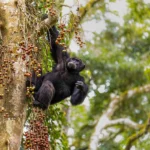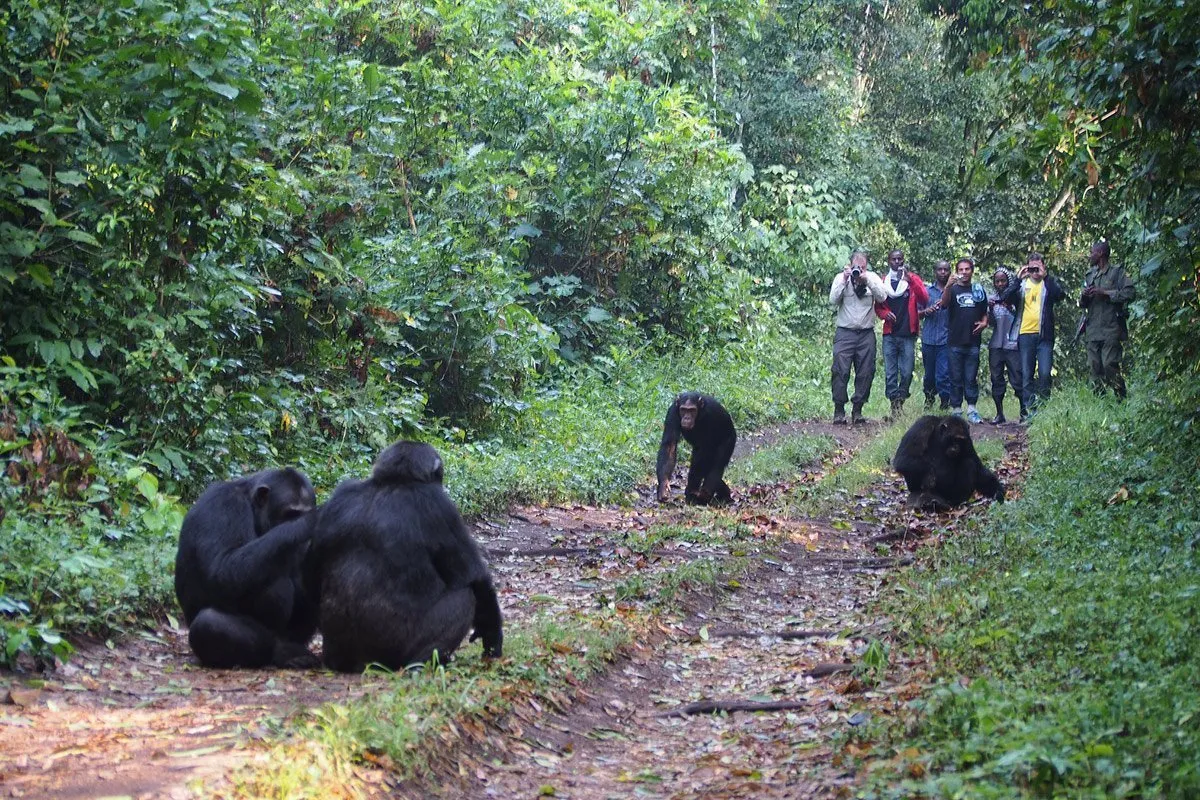
Do Chimpanzees in Uganda Live in the Wild or Semi-Captive Areas?
September 27, 2025
Do Birding Safaris in Uganda Include Cultural Experiences?
September 29, 2025Do Chimpanzees Move in Groups or Individually During Tracking?
One of the most fascinating questions asked by travelers preparing for Uganda Chimpanzee Safaris is: “Do chimpanzees move in groups or individually during tracking?” This inquiry reflects the curiosity of visitors eager to understand not only the logistics of chimpanzee tracking but also the social behaviors of one of humanity’s closest relatives. Uganda is one of the best destinations in Africa for observing chimpanzees in the wild, with protected habitats in Kibale Forest National Park, Budongo Forest, Kyambura Gorge, and Kalinzu Forest. Each location provides unique opportunities to witness chimpanzee dynamics, whether they are foraging alone or moving collectively through their territories.
When planning Uganda Safaris, knowing whether chimpanzees move in groups or individually is vital because it shapes expectations of the tracking experience. Chimpanzees live in complex social units known as communities or fission-fusion societies. These communities often split into smaller sub-groups for feeding or exploration, before reuniting at different points in the day. During Uganda Gorilla Trekking Safaris, tourists expect to meet mountain gorilla families that stay together as cohesive units. However, chimpanzee behavior is different, and understanding this distinction enriches every Uganda Wildlife Safari, ensuring visitors appreciate the uniqueness of each primate species.
Nkofu Africa Safaris emphasizes not just the activity of tracking but also the educational value behind it. By asking “Do chimpanzees move in groups or individually during tracking?”, travelers gain insight into chimpanzee ecology, their adaptive strategies, and how such behaviors influence the tracking experience. This knowledge ensures that Uganda Best Safaris go beyond sightings, providing travelers with deep connections to the wildlife and cultures of Uganda.
Understanding Chimpanzee Social Structure
To answer “Do chimpanzees move in groups or individually during tracking?”, one must first understand their social organization. Unlike mountain gorillas, which live in tightly-knit family groups led by a dominant silverback, chimpanzees live in fission-fusion communities. These communities can be large, sometimes numbering over 100 individuals, yet daily movements often involve smaller sub-groups called “parties.”
During Uganda Chimpanzee Safaris, travelers may encounter a party consisting of a few adult males, females with infants, or mixed groups. Sometimes, individual chimpanzees break away to forage quietly on their own, only to rejoin the larger party later. This dynamic nature means that the tracking experience varies daily. At times, visitors may find a lively group of chimps feeding together in a fig tree, while on other occasions, they might observe solitary individuals moving silently through the undergrowth.
By asking “Do chimpanzees move in groups or individually during tracking?”, visitors discover that flexibility is key in chimpanzee tracking. Guides at Kibale Forest or Budongo often emphasize patience and attentiveness. Unlike gorilla trekking, where groups are usually found together, chimpanzee tracking requires following vocalizations, drumming sounds, and feeding signs to locate them. This unpredictability makes every Uganda Wildlife Safari thrilling and distinct, reinforcing Uganda as a leading destination for primate tourism.
Comparing Gorilla and Chimpanzee Tracking
Travelers often compare experiences, leading to the important question: “Do chimpanzees move in groups or individually during tracking?” While gorillas live in stable family units that move as a group, chimpanzees present a more fluid picture. This comparison enriches Uganda Gorilla Safaris and Uganda Chimpanzee Safaris, as visitors witness two contrasting primate societies in their natural habitats.
On Uganda Gorilla Trekking Safaris in Bwindi Impenetrable Forest or Mgahinga Gorilla National Park, tourists reliably encounter gorilla families staying together. This predictability makes gorilla trekking more straightforward, with trackers following fresh signs like nests or droppings to find cohesive groups. In contrast, chimpanzee tracking in Kibale or Kyambura Gorge requires adapting to the possibility of seeing chimps either alone or in small groups scattered across the forest.
The question “Do chimpanzees move in groups or individually during tracking?” highlights how Uganda Safaris offer travelers multi-dimensional wildlife encounters. By combining Uganda Gorilla Trekking Safaris with Uganda Chimpanzee Safaris, visitors experience both tightly bonded gorilla families and the flexible, unpredictable dynamics of chimpanzee communities. This contrast not only enriches the safari but also enhances travelers’ understanding of primate diversity, cementing Uganda’s position as a global hotspot for primate tourism.
Daily Patterns of Chimpanzee Movements
Another way to approach the question “Do chimpanzees move in groups or individually during tracking?” is by observing their daily routines. Chimpanzees rise early, leaving their nests at dawn to forage for fruits, leaves, insects, and sometimes small animals. During these hours, individuals may split into smaller feeding parties, spreading across the forest to reduce competition for resources.
As the day progresses, chimpanzees often regroup at fruiting trees or rest in shaded areas. This fission-fusion pattern means that Uganda Chimpanzee Safaris may begin with travelers encountering a solitary chimp feeding quietly, followed by exciting moments of several chimps reuniting, grooming each other, or engaging in vocal displays. By afternoon, they may rest again before building fresh nests for the night.
Asking “Do chimpanzees move in groups or individually during tracking?” reveals the role of food availability and social bonds in shaping chimpanzee movement. For tourists, this means that chimpanzee tracking requires flexibility and patience. With experienced guides from Nkofu Africa Safaris, travelers learn to follow subtle cues, such as distant pant-hoots or tree movements, to locate chimps. These insights transform tracking into an adventure of discovery, making Uganda Best Safaris deeply rewarding for nature enthusiasts.
Birding and Cultural Additions to Chimpanzee Tracking
When travelers inquire “Do chimpanzees move in groups or individually during tracking?”, Nkofu Africa Safaris often recommends enhancing the experience by combining it with Uganda Birding Safaris or Uganda Cultural Safaris. Kibale Forest, for example, is not only famous for chimpanzees but also home to over 370 bird species, including the African Grey Parrot and Great Blue Turaco. A morning chimpanzee trek can be followed by an afternoon birding walk, extending the safari experience.
Cultural encounters further enrich Uganda Safaris. Communities near Kibale and Budongo forests offer visitors opportunities to learn about traditional healing practices, farming, and storytelling. These cultural safaris answer questions like: “What else can I do alongside chimpanzee tracking in Uganda?” The result is a holistic journey where tourists connect with both wildlife and people.
By integrating chimpanzee tracking with Uganda Gorilla Trekking Safaris, Uganda Birding Safaris, and Uganda Cultural Safaris, travelers not only address the question “Do chimpanzees move in groups or individually during tracking?” but also create an itinerary that balances wildlife adventures with cultural immersion, delivering Uganda Best Safaris experiences that appeal to global audiences.
Seasonal Influences on Chimpanzee Group Movements
A key factor in answering “Do chimpanzees move in groups or individually during tracking?” is the season. During the dry season, fruiting trees may be scarce, prompting chimpanzees to split into smaller groups or forage alone to cover larger areas. This means Uganda Chimpanzee Safaris during these months might involve tracking individuals or small clusters moving quickly through the forest.
Conversely, in the wet season when fruits are abundant, chimpanzees often gather in larger groups around food sources, creating more vibrant tracking encounters. Visitors may witness social behaviors such as grooming, playing, or males displaying dominance through drumming and calls. These group encounters often make tracking easier, as vocalizations help guides locate them faster.
Asking “Do chimpanzees move in groups or individually during tracking?” underscores the importance of seasonal planning. Nkofu Africa Safaris advises travelers on the best times to track chimpanzees depending on their expectations—whether seeking solitary encounters or bustling group dynamics. Combining such seasonal chimpanzee adventures with Uganda Gorilla Safaris or Uganda Birding Safaris ensures a balanced safari experience, showcasing Uganda’s biodiversity in all its forms.
The Role of Guides in Chimpanzee Tracking
When exploring the question “Do chimpanzees move in groups or individually during tracking?”, it becomes clear that the role of professional guides is crucial. Experienced rangers and trackers possess deep knowledge of chimpanzee behavior, vocalizations, and movement patterns. They interpret signs such as broken branches, fresh nests, or distant calls, helping tourists maximize their chances of observing both individual and group chimpanzees.
Guides also ensure safety during Uganda Chimpanzee Safaris. Chimpanzees, while generally tolerant of human presence, are strong and sometimes unpredictable. Proper distance must be maintained, whether observing a solitary male or a noisy group in a fruiting tree. Nkofu Africa Safaris prioritizes training and professionalism, ensuring that guests not only ask “Do chimpanzees move in groups or individually during tracking?” but also leave with in-depth knowledge about conservation and responsible tourism.
By working with skilled guides, travelers enjoy Uganda Best Safaris that are safe, educational, and unforgettable. The presence of experts ensures that every encounter, whether with an individual chimpanzee or a large party, is both meaningful and respectful of the animals’ natural behavior.
Conclusion – Do Chimpanzees Move in Groups or Individually During Tracking?
So, do chimpanzees move in groups or individually during tracking? The answer is both. Chimpanzees live in large communities that split into smaller parties or solitary individuals depending on food availability, season, and social dynamics. This makes every Uganda Chimpanzee Safari unique, with encounters ranging from solitary foragers to bustling groups engaged in playful or social behaviors.
Understanding this dynamic enhances Uganda Safaris, especially when combined with Uganda Gorilla Trekking Safaris, Uganda Birding Safaris, and Uganda Cultural Safaris. Unlike gorilla families that move as a unit, chimpanzees display flexible fission-fusion behavior, giving visitors a glimpse into one of the most complex primate societies.
By asking “Do chimpanzees move in groups or individually during tracking?”, travelers embark on a journey of discovery that goes beyond sightings to embrace knowledge, conservation, and cultural understanding. With Nkofu Africa Safaris, visitors enjoy Uganda Best Safaris designed around expertise, trustworthiness, and immersive experiences, ensuring that every safari is not just an adventure but a meaningful connection to Uganda’s natural and cultural heritage.

